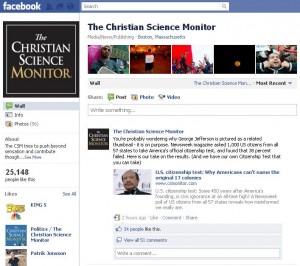Want To Stand Out In The Social Media Crowd? Build A Community Of Loyal Readers

Kevin Curley Social Media Specialist Christian Science Monitor
This week’s social media news comes to us from Kevin Curley, Social Media Specialist at The Christian Science Monitor. He directs the social online engagement strategy for CSMonitor.com, the web version of The Christian Science Monitor. Kevin’s main focus at the Monitor has been to build a loyal audience utilizing email newsletter campaigns and traditional social media platforms. We asked Kevin a few questions about online newspapers and the social media platforms he manages.
Q: How do you think online newspapers will function and fit in, in the future?
I wish I had the answers. From our standpoint, readers’ access to mobile technology has dramatically revolutionized the way we think about news consumption. No longer can we brag about the number of foreign bureaus or correspondents we have on-the-ground. These days, anyone with a smart phone can break news when and where it is happening. But covering newsworthy events goes way beyond just snapping a photo, uploading it to Twitter, and writing what you saw. That is where newspapers fit in the mix. Both have a role in media, but different roles nonetheless.
Journalists offer depth, context and hopefully, an unbiased perspective – at least that’s what we strive for at the Monitor. I don’t see this changing much in the future. What will change is how we consume news; print vs. online, tablet vs. phone, audio vs. video, etc. I think everyone is trying to figure out what works best, but I would put my money (like so many others) on a multimedia mobile approach; way beyond the iPad.
How will online newspapers function in the future? Anyone can follow trends, write a blog post and ride the wave. But, in my opinion, you have to build a community of loyal readers to stand out in the crowd. Take Slate.com for example. There you have a site with a relatively small number of unique visitors/month (7.5 million) compared to the enormous number of page views/month (80 million). They follow trends, create great content that readers want, and according to Quantcast, average more than 10 pages per unique visit; i.e. extreme reader loyalty.
I would bet that in every board room of every major news organization, whether television, radio or online, big people with big titles are coming up with big ideas that will transform their traditional old-school news site into some attractive multimedia landing page for a younger, hipper audience.
My role, is to help this new audience connect deeper to the Monitor community through our social media activity. By creating a community of engaged readers, we’re hoping they will become CSMonitor.com brand advocates; distributing our content to a larger audience – specifically their friends and family.
Q: How do you manage a Facebook page with over 25K fans and a Twitter account with 9,500+ followers?
 Managing Facebook is easy if you set the agenda or tone right away. Fan pages that let the fans dictate the tone can get out of control; its like having your pets sleep on the bed with you. At first, it may be cute, but after awhile, they run the show and you end up not getting any sleep.
Managing Facebook is easy if you set the agenda or tone right away. Fan pages that let the fans dictate the tone can get out of control; its like having your pets sleep on the bed with you. At first, it may be cute, but after awhile, they run the show and you end up not getting any sleep.
When I started the Monitor’s FB page in 2008, I set community rules that stated “no ranting, no name calling” and that the page reflected the mission of the newspaper, “to injure no man, but to bless all mankind.” Even as the number of fans increased, and with only one full-time staff member monitoring the fan page, the community has continued to be free of ranting – most of the time.
We engage with our readers, uphold the community rules, and most of all – try to create an environment where people feel comfortable offering their opinion. We feel its necessary to show a personal connection with the fans. We’re not perfect, some people get upset when their comment disappears, but overall I’m happy with the community we’ve built. The last time I looked at our Insights, out of the 25K, 85% were active, and we’re averaging about 4,000 interactions a month.
On Twitter, I would say I only invest about 5% of my time managing the account. With an organization trying to do more with less, we realized we can’t invest the time needed to make Twitter a big player for us. We do highlight our ‘Top RT’ers’ and ‘Top Influencers,’ but we don’t seek out influencers – it’s just not our style. In fact, we know that by being a trusted news source on Twitter, we’re the influencer.
Like most news organizations, the bulk of our referring traffic from Twitter comes from readers utilizing the share tools on our website. Looking ahead, we’ll try to expand those opportunities and really try to improve the user experience on CSMonitor.com. There’s probably more we can do with Twitter; Huffington Post, CNN, Mashable.com, and the Daily Beast are always leading the charge – but they’ve got the resources to pull that fancy stuff off with ease. I need to get a couple 100K more page views from Twitter before we start considering it a big player for traffic.
Next week Kevin will tell us where to look online to find the most recent social media news so stay tuned!
If you have suggestions for future Social Media News posts, want to ask questions or share thoughts, please feel free to email me. Thanks! – Laura




